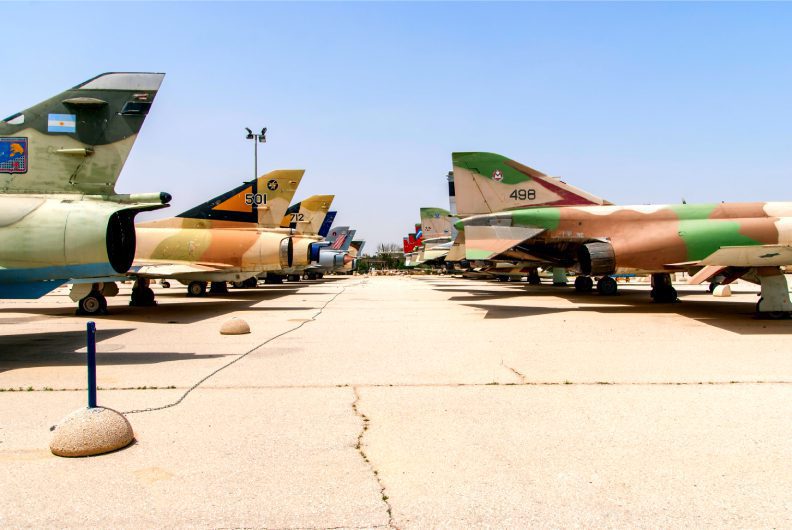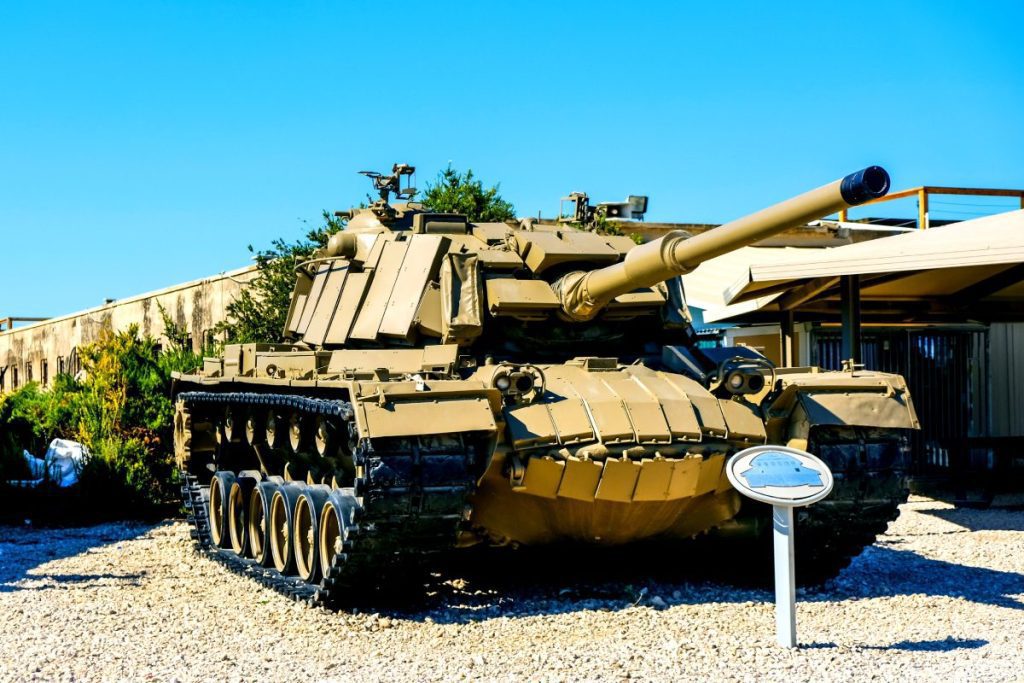On this IDF Museums tour, we would explore the different museums the IDF (Israeli Defence Forces) has to offer. And they’re quite a few I must say. So those military history buffs let’s go and explore them! My first recommendation would be The Israel Defense Forces History Museum. The museum displays various weapons used by the Haganah, Etzel, Palmach, and the IDF during the 20th century. The collection and display include pistols (including special pistols) and rifles. Including the Uzi; the Galilee, and Tavor; cannons such as the Napoleon cannon, Armored combat vehicles such as (tanks and rocket launchers).

AIR FORCE MUSEUM IN HATZERIM, ISRAEL
Experimental weapons developed by the defense industries are displayed; And alongside them weapons taken from the booty in the Israeli wars; such as Katyusha launchers and Sager missiles. The exhibits are displayed both in small booths and outside booths (mostly heavy vessels). As of January 1, 2019, the museum is closed while it’s being relocated to Latrun and is expected to reopen in 2021.
The Armored Corps Memorial Site and Museum
The Armored Corps Memorial Site and Museum at Latrun is Israel’s official memorial site for fallen soldiers from the armored corps, as well as one of the most diverse tank museums in the world! The site was created through the initiative of veteran officers of the armored corps. The outdoor display includes 110 tanks and other armored fighting vehicles; both Israeli and captured enemy examples including the Merkava Tank and T-34, T-54, T-55, T-62 tanks.
As well as vehicles obtained or purchased from allied nations specifically for diversifying the collection like the German Leopard tank or the only T-72 on display in Israel. Other notable items include: an M4 Sherman tank mounted high atop a former British water tower; a collection of mobile bridges constructed by the IDF (Israeli Defense Forces) which can be carried by tanks and erected while under fire; captured enemy vehicles, most of which Israel has modified and updated; a tank with a blown up gun; and a long, engraved commemorative wall bearing the names of Armored Corps soldiers killed in defense of the country.

BATTLE TANK MAGACH IN ISRAELI ARMORED CORPS MUSEUM AT LATRUN
The Tank on the Tower
The most famous sight at Yad La-Shiryon is most likely that of a tank on top of a tower, which serves as the museum’s logo. In 1979, by the decision of the late Major General (Ret.) Moshe Peled; the tank was hoisted on top of a tower on the site; which was originally used as a water tower. The tank that was chosen is an American M4 Sherman; one of the first tanks that fought in the service of the Israel Defense Forces. Since the water tower was only designed to support 25 tons and the tank weighed 34 tons; both the engine and transmission gears had to be removed.
IDF Museums Tour: Underground Prisoners Museum, Acre
Museum of Underground Prisoners – Acre is a memorial museum in memory of and members of the Hebrew Underground during the British Mandate, who were imprisoned in Acre Prison. The museum recounts the historical events that took place at the site and illustrates the lives of underground prisoners and the Prison Break to the Acre prison through audio-visual spectacle. The site dedicates memorial rooms to the nine victims of the Acre Prison Break and the nine that were sentenced to death by hanging by the British.
The museum is housed in the fortress of Acre which was built during the Ottoman period. The fortress served during the Ottoman rule as a military base; the residence of the governor of Acre, and even a prison. The first inmates of the underground to be imprisoned there, in 1912, were Chaim Sturman and Zvi Nisanov, members of the Hashomer organization.
The British Take Over
With the conquest of Acre by the British, in 1918, the place became the main prison in Israel during the British Mandate. Initially, the bulk of the prison population consisted of Arab prisoners, most of them plain criminals. In 1920, Ze’ev Jabotinsky was imprisoned there along with 19 of his friends who were defenders of Jerusalem during the events of 1904. Jabotinsky’s prison cell is open to visitors to the museum. During the entire British Mandate, hundreds of members of the underground; the Haganah, the Irgun; and the Lehi were imprisoned throughout Acre Prison.
Eight of the members who were tried in British Mandate courts and sentenced to death by hanging were found their death in Acre prison: Shlomo Ben-Yosef, Dov Gruner; Yechiel Dresner; Eliezer Kashani; Mordechai Alkahi; Meir Nakar; Avshalom Haviv, and Yaakov Weiss. On May 4, 1947, Irgun fighters broke into the Acre prison and released 41 of their comrades who were held there; during the operation nine died.
IDF Museums Tour: The Haganah Museum
The Haganah Museum is the main museum of the history of the Haganah organization located on Rothschild Boulevard in Tel Aviv-Yafo. The museum presents the history of the Haganah in the Jewish community in Eretz Israel during the British Mandate. The museum is spread over three floors; including modern exhibits about the settlement; the auditorium, and the organization archive. It also features two preserved rooms from the house that depict the lifestyle of the period in Little Tel Aviv. The house is also considered an architectural gem with painted floors, stone carpets, and ornate walls.
The house was formerly the home of Eliyahu Golomb, the supreme commander of the Haganah and the “Minister of Defence” of the Jewish Settlement in Palestine. The building was designated for preservation; in part because of its architectural quality and historical importance.
IDF Museums Tour: Museum of Underground Prisoners, Jerusalem
Museum of Underground Prisoners is a museum in Jerusalem, Israel, commemorating the activity of the Jewish underground—Haganah, Irgun, and Lehi—during the period leading up to the establishment of the State of Israel. The museum is located in a building in the Russian Compound that served as the central prison of the British Mandatory authorities. The building was erected as a hostel for Christian pilgrims towards the end of the Ottoman period when the European powers sought to strengthen their hold on Palestine. The Russian Compound, built outside the Old City, included a church, a hospital, and pilgrim hostels for men and women.
Israeli Air Force Museum
In 1917, the British conquered Palestine from the Ottoman Turks. The women’s hostel was transformed into the central British prison. With long hallways leading to separate rooms, it was an ideal layout for a prison. Over the course of the British occupation; hundreds of prisoners passed through its gates. Jews and Arabs were incarcerated together. While the facility housed many death-row inmates, members of the Jewish underground sentenced to death were executed in Acre.
When we will tour the site we will see various interesting points of exhibits:
Detention: the registration and reception room is located to the right of the entrance to the jail. A new prisoner was registered and given a haircut. His personal belongings were stored, and after receiving his prison clothes in the “clothes storeroom” he was assigned to a cell.
Prisoner cells: In the cells, the prisoners’ brown garb, the “burshes” (mats) upon which the prisoners slept, and the “kardal”, the bucket that was used as a toilet can be seen. The bed in the corner near the window was for the “mukhtar”, the prisoner that the British made responsible for the conduct of the prisoners in the cell.
Moshe Barazani and Meir Feinstein
Moshe Barazani, a member of Lehi, and Meir Feinstein, a member of Etzel, were sentenced to death in 1946 because of their involvement in the attempted assassination of a British officer and a bombing attack on a Jerusalem railway station in which a policeman was killed. At the initiative of the two underground groups and with the agreement of the two condemned men, it was decided to thwart the plans of the executioners. The plan was to smuggle into their cell two improvised hand grenades. The first-hand grenade would be thrown at the hangmen including the warden during the planned execution. The second-hand grenade would be used for the two condemned men to take their lives. I’ll tell you all about it during the tour!







